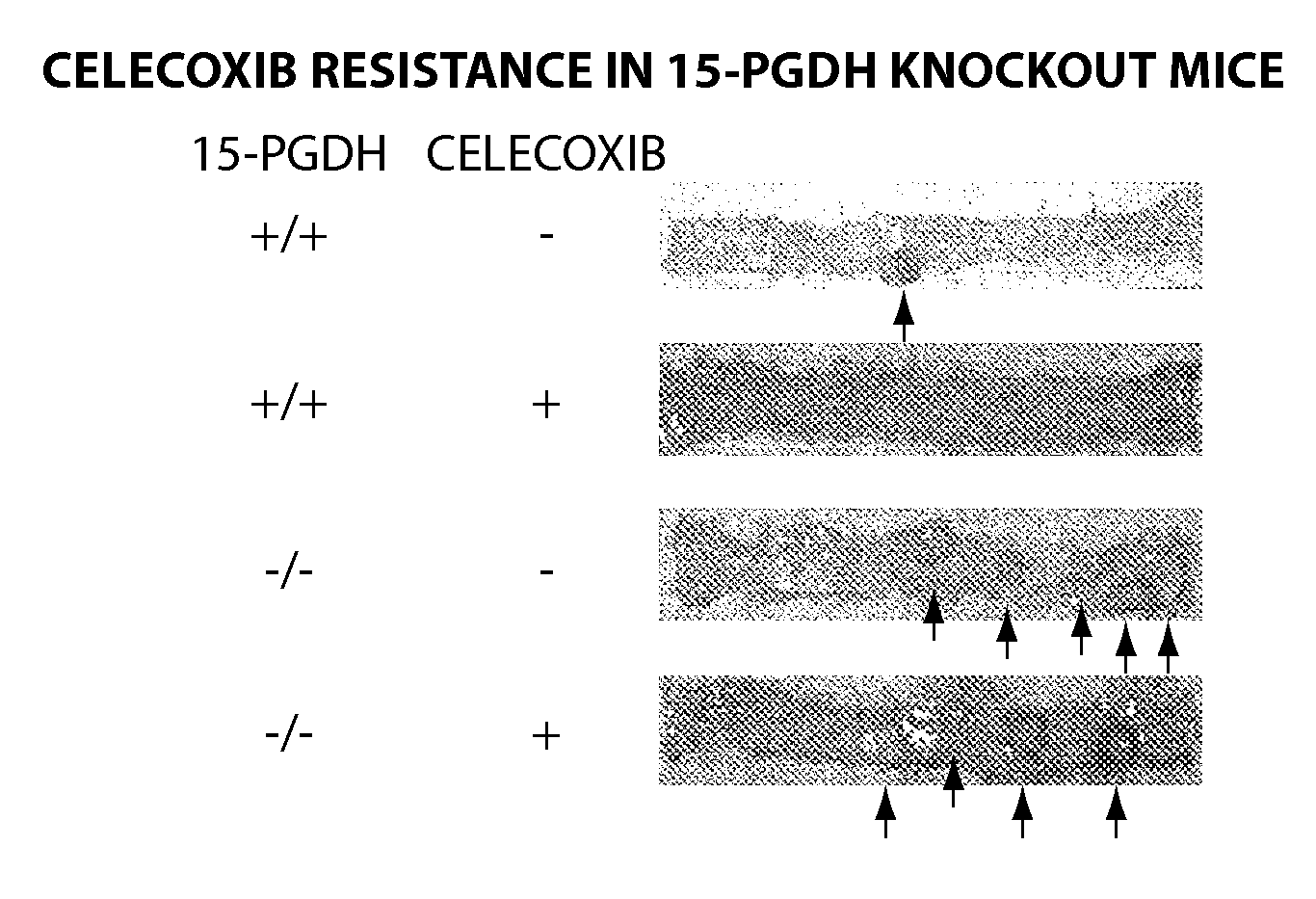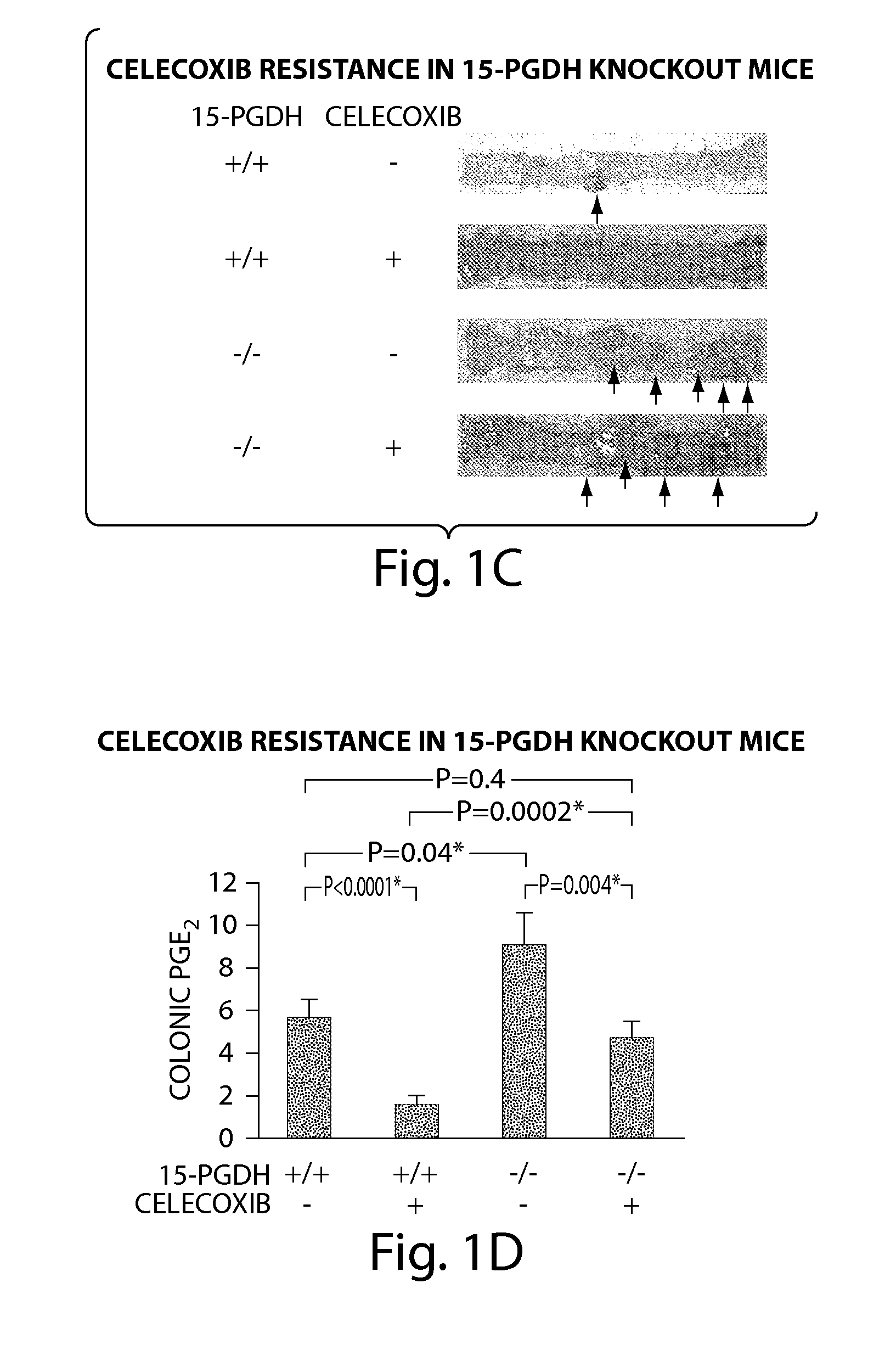15-pgdh in colon cancer
a technology of colon cancer and pgdh, which is applied in the field of 15pgdh in colon cancer, can solve the problems that no treatment has shown sufficient anti-tumor activity to prolong the survival of colon cancer patients with metastatic disease with any degree of reliability, and the molecular mechanism underlying this resistance is largely unknown
- Summary
- Abstract
- Description
- Claims
- Application Information
AI Technical Summary
Benefits of technology
Problems solved by technology
Method used
Image
Examples
example 1
15-PGDH is Required for Celecoxib Prevention of Murine Colon Tumors
[0193]To conduct this study FVB mice were selected, chosen because at baseline this mouse strain is sensitive to AOM induced colon tumors (Nambiar, P. R. et al., (2003) Int Oncol 22, 145-50). In 15-PGDH wild-type FVB mice, AOM induced 2.3±0.4 tumors per mouse colon (FIG. 1A, 1C), which on histology review were all adenomatous lesions. As in human trials, administering dietary celecoxib protected wild-type FVB mice against colon tumor development, reducing adenoma development to 0.7±0.3 tumors per mouse (P=0.003) (FIG. 1A, 1C). Furthermore, while nearly all tumors arising in control mice exceeded 1 mm in size, tumors in celecoxib treated mice rarely reached this size (2.2±0.4 versus 0.3±0.1, P<0.0001) (FIG. 1B).
[0194]Dietary celecoxib could thus near completely protect wild-type FVB mice from developing colon tumors. Further investigation however revealed that the ability of celecoxib to protect mice from colon tumors...
example 2
15-PGDH is Required for Celecoxib Reduction of Colonic PGE2
[0195]To further investigate the mechanism of celecoxib's dependence on 15-PGDH, we determined PGE2 levels in colonic mucosa of FVB mice under different experimental conditions. Consistent with the role of 15-PGDH in mediating prostaglandin degradation, 15-PGDH gene knockout essentially doubled FVB colonic PGE2 levels (9.1±1.5 ng / mg protein in knockouts versus 5.70±0.8 ng / mg protein in controls, P=0.04) (FIG. 1D). Celecoxib treatment of 15-PGDH wild-type mice markedly lowered PGE2 levels to 1.6±0.4 ng / mg protein (P2 levels to only 4.7±0.8 ng / mg protein. This level was three-fold the level achieved in drug treated wild-type mice (P=0.0002), and was not significantly different from the PGE2 level of drug free wild-type mice (P=0.4) (FIG. 1D). In overview, the efficacy of celecoxib in lowering colonic PGE2 levels in these different models closely paralleled the drug's anti-tumor activity (FIG. 1D versus FIG. 1A, 1B), and mice ...
example 3
Low 15-PGDH Levels are Associated with Celecoxib Resistance in Humans with Recurrent Colon Adenomas
[0196]These observations in mice suggest that humans with lower levels of colonic 15-PGDH might also be resistant to the colon tumor prevention activity of celecoxib. To test this hypothesis, we examined frozen biopsies of rectal mucosa obtained from 16 individuals at the time of their enrollment in the Adenoma Prevention with Celecoxib (APC) trial (Bertagnolli, M. M. et al., (2006) N Engl J Med 355, 873-84). These individuals were all at high risk for colon adenoma development based on having had multiple colon adenomas and / or adenomas greater than 5 mm in diameter prior to their enrollment. Following clearing of their colonic adenomas by colonoscopy, each individual received 36-months of daily treatment with celecoxib (Bertagnolli, M. M. et al., (2006) N Engl J Med 355, 873-84). Measurement by real-time PCR of 15-PGDH transcript levels in these pre-treatment biopsy samples showed a 1...
PUM
| Property | Measurement | Unit |
|---|---|---|
| Fraction | aaaaa | aaaaa |
| Electrical resistance | aaaaa | aaaaa |
| Level | aaaaa | aaaaa |
Abstract
Description
Claims
Application Information
 Login to View More
Login to View More - R&D
- Intellectual Property
- Life Sciences
- Materials
- Tech Scout
- Unparalleled Data Quality
- Higher Quality Content
- 60% Fewer Hallucinations
Browse by: Latest US Patents, China's latest patents, Technical Efficacy Thesaurus, Application Domain, Technology Topic, Popular Technical Reports.
© 2025 PatSnap. All rights reserved.Legal|Privacy policy|Modern Slavery Act Transparency Statement|Sitemap|About US| Contact US: help@patsnap.com



